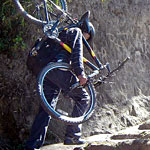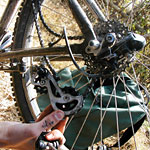 Blistering down a narrow dirt trail on a mountain bike you realise how true this is. On the steeper sections we snake around rocks, fly over stray branches and freewheel at 40km/hr. We pass a porter carrying a sack of rice to his village, children wave from the side of the road, low bamboo branches whip our helmets. The tires hum and the brakes hiss as the trail widens into the outskirts of a village at the bottom of the mountain. We finally pull on the brakes and come to a stop in a cloud of dust.
Blistering down a narrow dirt trail on a mountain bike you realise how true this is. On the steeper sections we snake around rocks, fly over stray branches and freewheel at 40km/hr. We pass a porter carrying a sack of rice to his village, children wave from the side of the road, low bamboo branches whip our helmets. The tires hum and the brakes hiss as the trail widens into the outskirts of a village at the bottom of the mountain. We finally pull on the brakes and come to a stop in a cloud of dust.
The rule of mountain biking in Nepal is that every descent is followed by an ascent. And sure enough, there is another pass to climb. I take off my jacket and stuff it into my bag, take a large gulp of water and begin the hard climb to the next summit. The first few kilometers are negotiated on sheer adrenalinebut I soon run out of that. Panting heavily in the thin air, my mouth parched, sweat rolls down my forehead and stings my eyes. Heading down, all I can see is my shadow rushing past rocks, bobbing in synch with my pedaling and panting.
Why do it? They ask. I ask myself that too and it must be that each ride is a new journey, a different challenge and it almost doesn't matter where the destination is. My most ambitious ride so far was the 120-km cross-country from Kathmandu to the Tibet border. The night before, I couldn't sleep because of nervousness. I'd done that highway by jeep, and remembered the steep switchbacks up to the mountain pass and the endless asphalt to the Friendship Bridge. Sleepless, I tossed and turned, toying with the idea of not going. What if I didn't make it? I could always call my friends in the morning and say I was sick. But I did go and that two-day trip was the most exciting thing I had ever done.
Another journey, this time it's not endurance but skill as I negotiate a steep trail to a mountain-top temple. At the summit, I haul my aching body off my bike and stagger to the rocky steps of the shrine. The coolness of the grass and the breeze soothe me. The sense of accomplishment is indescribable. I gaze up at the sky, at this altitude a blinding blue with clouds cresting the adjoining ridges like a waterfall. Paddy fields cascade down the hill, checker-boarding the terrain into various shades of green. Across the northern horizon each peak of the central Himalaya seems to have a personality of its own: Ganesh appears busy, Langtang has a self-confident air, the twin peaks of Gauri Shankar look engrossed in each other and Dorje Lakpa leans languidly on his fellow mountains. A solitary eagle soars in the updraft, wings outstretched and steering with the imperceptible movements of his feathers. It is joined by another and they go around in lazy circles together, inspecting the slopes below.
This is why I do it. This is why I get up early on weekends, strap on my helmet and ride out.
High on the pass at Lakuri Bhanjyang, I am disconnected from the bustle of the city. The peace seeps into my body as I contemplate the lodge to stay for the night. The next morning, it is time to head back down. I relish the prospect of rushing down a slope that was so difficult to climb. I glide down effortlessly.
From the valley below, I look back at the old temple where I started off: just a speck on the top of the mountain. "I was there," I tell myself and continue on my journey.
MOUNTAINS+BIKES=THRILLS
It's no surprise that because of its terrain, Nepal offer some of the most exhilarating and challenging rides in the world to mountain bike. It's small enough to become familiar with, yet large enough to get lost in, making it ideal for thrill seekers, professionals, and those who simply want a day away from the madness of daily life. And because many parts of the country are still roadless Nepal offers all grades of biking.
Nepal is host to an array of international adventure races including the Action Asia Challenge and the Himalayan Mountain Bike races with pro-riders from Europe Asia and the USA testing the difficult terrain and competing for international glory.
But for the amateurs or those who just want a weekend out of the city, there is something for every level of rider. From driving up to the top of Nagarkot in your jeep with a bike and simply speeding back down, to the epic battle against altitude and below zero temperatures at Chomolungma Base Camp, there is something for everyone.
 KATHMANDU-KAKANI (50km)
KATHMANDU-KAKANI (50km)
Longer than the Nagarkot trail is Kakani on the Valley's western rim. Starting at Balaju you cruise past Nagarjun forest where the humming of cicadas reaches a crescendo. You reach the Mainju Pass and then begins the long serpentine tarmac to Kakani. The pass is at 2700m and the view of Ganesh Himal wipes out the strain. After recharging your batteries you may either head a further 3km up to the radio tower or coast back down. Take lots of liquids and stack up on chocolates at the base.
 KATHMANDU-BHAKTAPUR-NAGARKOT (38km)
KATHMANDU-BHAKTAPUR-NAGARKOT (38km)
An early morning breakfast of eggs and toast and off you go. Heading east to Bhaktapur before the traffic gets really bad. You weave past trucks and rampaging minibuses until you get to the base of hill. The 20km climb up to Nagarkot winds all the way to the summit and it may take up to one-and-a-half-hours depending on your stamina and endurance. Upon reaching the top you will be greeted by a view of the entire Central Himalaya. You may want to go down a different way and take the sandy trail to Changu Narayan or Sankhu. Autumn and early winter is the best time for this ride.
KATHMANDU-PANAUTI-LAKHURI BHANJYANG (60km)
For those of you ready for a full day of riding, this circuit packs in asphalt, climb, dirt trails and steep descents. You can also ride to Banepa via the Arniko Highway and turn south to Panauti. Ride the jeep track past Kushadebi and Ryale villages until you start a 10 km incline that is gradual but continuous. Pace yourself and conserve your energy. Lakhuri Bhanjyhang is ridge so you will not be able to see it until you get there. At the top have some tea and biscuits and take a rest. The ride down to Lubhu inKathmandu Valley is a roller coaster.
 KATHMANDU-TATOPANI-KATHMANDU (240km 2 days)
KATHMANDU-TATOPANI-KATHMANDU (240km 2 days)
For a weekend getaway Tatopani is an ideal destination. Plan ahead of time, all you need is spare clothing, some food and lots of water. Meet your friends at a common spot early in the morning, possibly around 7AM and start the roughly 129km journey to the Tibet border. The journey will take you past Dhulikhel, down into Dolalghat, along the Indrawati into Panchkhal, through Barabise and finally into Tatopani. The ride provides for thrilling high speed downhill racing and steep endless uphills. By midday you should reach Lamosangu where you can stop for lunch. The key to reaching Tatopani before dark is to pace yourself and use up all your energy in the comparatively easier sections. Be sure to take equipment while still traveling light. Let your bones relax in the hot spring and if you are still looking for a thrill go bungee jumping at The Last Resort.
 HATTIBAN:Training in Intervals
HATTIBAN:Training in Intervals
Ever find yourself panting and gasping for air, your legs having begun producing lactic acid and you on the verge of giving up? Well training in intervals is the best way to increase strength and stamina. Start from the base of the jeep track leading up to Hattiban Resort. Negotiate the steep road and switchbacks until you reach the resort. Then take a 30 second rest and head back down. Once at the base take a minutes rest and head back up and follow the same routine until you've been up and down three times. It should take no more than 15 minutes to reach the top. Time yourself each of your intervals and record your progress.
 THE RIGHT EQUIPMENT
THE RIGHT EQUIPMENT
You're looking for a bike that is not only strong but also designed to fit you. While trying out new bikes, get on it, ride it around the block, make sure it is not to high or too low. You and your bike will become very close as you start riding so you are looking for a long-term investment. There are shops in Kathmandu selling Gary Fisher, Trek, Giant and Specialised bikes worth up to $ 2,000. The trick is not to go for an expensive one right away, start off with models in the Rs 20,000 range and if you find yourself really enjoying the great outdoors you can always upgrade.
 TOOL CHECKLIST
TOOL CHECKLIST
Available at bike stores in the Jamal and Thamel areas
. Tire pump (make sure it fits your valve Presta or Schrader)
. Spare tube (Presta or Schrader)
. l Patch kit (for your tubes)
. Tire lever
. Screwdriver
. Allen wrenches (2, 4, 5, 6mm)
. Chain tool (spare Shimano chain pins)
. Small crescent wrench
. Small first aid kit


